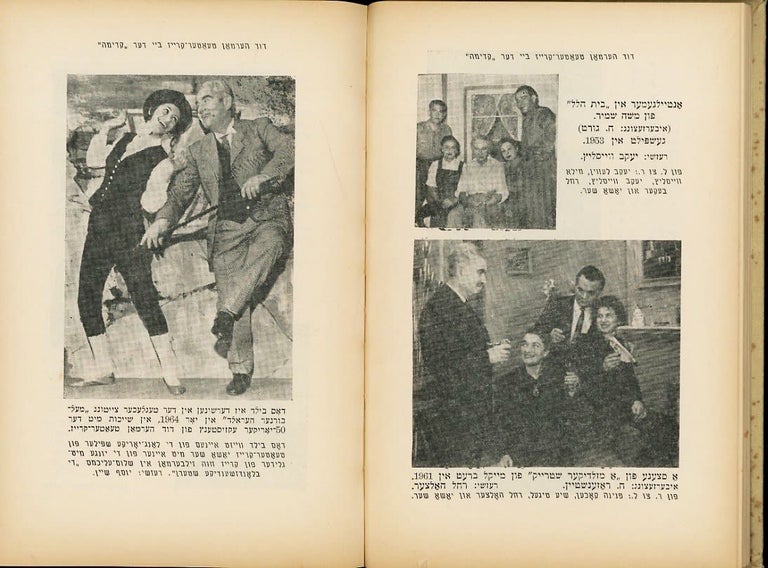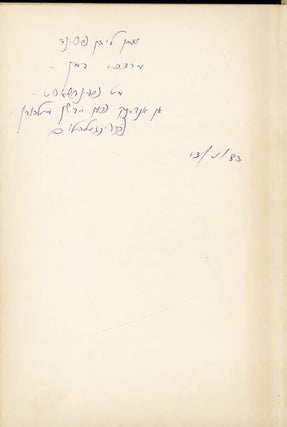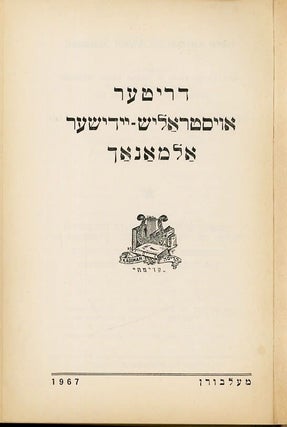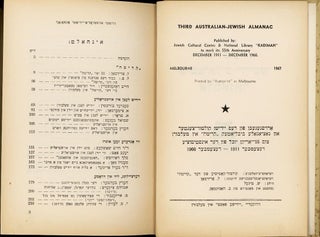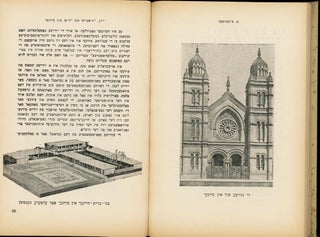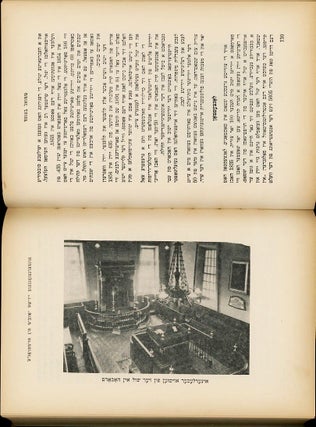DRITER OYSTRALISH-YIDISHER ALMANAKH. דריטער אויסטראליש־יידישער אלמאנאך.
Melborn [Melbourne]: Yidishn Kultur-Tsenter un natsionale bibliotek "Kadimah" 1967. Item #42160
1st edition. Original illustrated publisher’s cloth, 8vo, 456 pages. 22 cm. Includes many photos. In Yiddish. Title translates as, “Third Australian-Yiddish Almanac.” "Published by Jewish Cultural Centre & National Library "Kadimah" to mark its 55th Anniversary December 1911 - December 1966" (on title page verso). “ In the 2016 census, there were 21,175 Australians who identified as Jewish by ancestry, a decrease from 25,716 in the 2011 census, and 91,016 Australians who identified as adherents of Judaism, which is a 6% decrease on 97,355 adherents of Judaism in the 2011 census. The actual number is almost certainly higher, because an answer to the religion question on the census was optional and because Holocaust survivors, Haredi Jews or many non-practising Jews are believed to prefer not to disclose religion in the census. By comparison, the Israeli newspaper Haaretz estimated a Jewish-Australian population of 120,000-150,000 (not limited to adherents of Judaism), while other estimates based on the death rate in the community estimate the size of the community as 250,000. Based on the census data, Jewish citizens make up about 0.4% of the Australian population. The Jewish community of Australia is composed mostly of Ashkenazi Jews, though there are Jews in Australia from many other traditions and levels of religious observance and participation in the Jewish community…..The first Jews to come to Australia were at least eight English convicts transported to Botany Bay in 1788 aboard the First Fleet. About 15,100 convicts were transported by the time transportation ceased in 1840 in New South Wales and 1853 in Tasmania. It is estimated that of those who arrived by 1845 about 800 were Jewish. Most of them came from London, were of working-class background and were male. Only 7% of Jewish convicts were female, compared with 15% for non-Jewish convicts. The average age of the Jewish convicts was 25, but ranged from 8 to elderly….The first move toward organisation in the community was the formation of a Chevra Kadisha (a Jewish burial society) in Sydney in 1817, but the allocation of land for a Jewish cemetery was not approved until 1832. In 1830 the first Jewish wedding in Australia was celebrated, the contracting parties being Moses Joseph and Rosetta Nathan. Jewish immigration in the interwar period came at a time of antisemitism and the White Australia policy. The Returned Services League and other groups publicised cartoons to encourage the government and the immigration Minister Arthur A. Calwell to stem the flow of Jewish immigrants. Sephardi Jews first immigrated to Australia in the mid-to-late 19th century, and the community thrived for some twenty years, there was a Sephardic congregation, and some Sephardi families occupied important communal positions. Gradually, however, the Sephardi population declined, and the congregation was disbanded in 1873. A new Sephardic community also emerged in the post-war period. Previously, Mizrahi Jews were generally not permitted to enter due to Australia's White Australia policy. However, following the Suez Crisis in 1956, a number of Egyptian Jews were allowed to enter. Over the following years, overtures from Jewish communities led the government to drop its previous stance on entry of Mizrahi Jews. By 1969, when Iraqi Jews were being persecuted, the government granted refugee status to Iraqi Jews who managed to reach Australia….Hitler's ascent to power and the horrors of World War II also brought large numbers of refugees from central Europe. From the mid-1930s, Temple Beth Israel in Melbourne became the basis of a Reform community because of its newly arrived German members. The Temple's German-born rabbi played an integral role in promoting the movement and, in 1938, when visiting Sydney, he established Temple Emanuel. It also attracted many Jews from Germany and other parts of Central Europe, who arrived in Sydney prior to the outbreak of the war. The 1940s and 1950s saw the emergence of ultra-Orthodox Haredi and Hasidic communities in Sydney and Melbourne. The first Sephardic synagogue in Australia was founded in 1962. There had been at least two short-lived efforts to establish Reform congregations, the first as early as the 1890s. However, in 1930, under the leadership of Ada Phillips, a Liberal or Progressive congregation, Temple Beth Israel, was permanently established in Melbourne. In 1938 the long-serving senior rabbi, Rabbi Dr Herman Sanger, was instrumental in establishing another synagogue, Temple Emanuel in Sydney. He also played a part in founding a number of other Liberal synagogues in other cities in both Australia and New Zealand. The first Australian-born rabbi, Rabbi Dr John Levi, served the Australian Liberal movement. In 2012, the first Humanistic Jewish congregation, known as Kehilat Kolenu, was established in Melbourne, with links to the cultural Jewish youth movement Habonim Dror. Later in 2012, a similar congregation was established in Sydney, known as Ayelet HaShachar” (Wikipedia). SUBJECT(S): Jews -- Australia. Juifs -- Australie. Almanacs, Yiddish -- Juifs -- Almanachs OCLC: 122732918. OCLC lists 9 copies outside Australia. Some spotting to cover, some toning to paper, Very Good Condition. YID-43-10-LE-’x).
Price: $200.00


